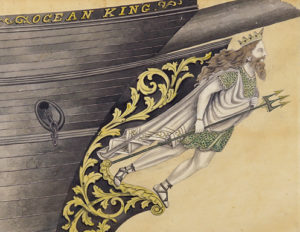July/August | view this story as a .pdf
There was a time when no good ship sailed from Casco Bay without a figurehead beneath her bow. The finest came from Portland’s Nahum Littlefield, a master of this lost American art.
By Herb Adams
 During the mid-19th century, when Portland was at the helm of the wooden shipbuilding trade, at least half a dozen ship carvers worked the Portland waterfront, cutting boards for vessels from Freeport to Kennebunk. While the Patten, McLellan, and Sewall shipyards in Bath were hives of industrious engineering, the ship carver’s work more closely resembled an art form. The craftsmen would spend their days fashioning stern boards and tailboards; elegant scrollwork inscribed with the vessel’s name to be mounted at the ship’s bow; and 20-foot gilded eagles, wings outspread above banners emblazoned with the vessel’s homeport. But of these works, it was the figurehead that symbolized the personality, even the life, of the ship itself. Ornate, imposing figures cut from Maine timber dashed across the seas in the form of exotic ladies; mermaids and mermen; or colorfully carved figures of Lincoln or Columbus, flung to far-away places by a young nation eager to capture the commerce of the world. Some ship owners even had their own images carved and mounted onto the front of their vessel. Talk about showboating.
During the mid-19th century, when Portland was at the helm of the wooden shipbuilding trade, at least half a dozen ship carvers worked the Portland waterfront, cutting boards for vessels from Freeport to Kennebunk. While the Patten, McLellan, and Sewall shipyards in Bath were hives of industrious engineering, the ship carver’s work more closely resembled an art form. The craftsmen would spend their days fashioning stern boards and tailboards; elegant scrollwork inscribed with the vessel’s name to be mounted at the ship’s bow; and 20-foot gilded eagles, wings outspread above banners emblazoned with the vessel’s homeport. But of these works, it was the figurehead that symbolized the personality, even the life, of the ship itself. Ornate, imposing figures cut from Maine timber dashed across the seas in the form of exotic ladies; mermaids and mermen; or colorfully carved figures of Lincoln or Columbus, flung to far-away places by a young nation eager to capture the commerce of the world. Some ship owners even had their own images carved and mounted onto the front of their vessel. Talk about showboating.
Master of His Craft
Among these carvers, Portland’s Nahum Littlefield could teach a master class. From his hand came “Neptunes, female figures with flowing robes” as well as “figures of the gods and goddesses,” said admiring newspapers, “Saints, life-size representations of ship owners, and sweethearts.” A city of fantastic forms, “white and gilded figures…all done in wood.”
Though he never went to sea himself, Littlefield was born in 1833 with saltwater in his veins. The son of two generations of ship carvers, his grandparents had lived beside the harbor in Falmouth until it was burned to the ground by the British in 1775. As if in defiance, Littlefield never ventured far from the waterfront, and his carving shops always faced the ocean.
Lost Imagery
The Civil War and the advent of iron ships ended Portland’s golden era of wooden boat building–and with it, figureheads and the men who made them. Smithsonian experts estimate that fewer than 1,000 Americanmade figureheads exist today. Most rest beneath the waves. When Littlefield passed on in June 1916, aged 83, his obituaries remembered him as Portland’s Fire Chief (1877-1881 and 1883), who fought the infamous blaze of July 4, 1866. His career as an artist and craftsman on the waterfront is only a fleeting memory in the fast-industrializing 20th century. “A ship’s carver by trade,” noted the Evening Express. “Considered by many to be an artist in that line of business.”
Portlanders can still see evidence of Littlefield’s art in his hometown. The Portland Fire Museum on Spring Street houses an eight-foot gilded eagle, wings illustriously spread, which once adorned Littlefield’s own fire truck. Below it stands a polished chair carved from the elm tree under which Lafayette once spoke while visiting Portland in 1825. Both are relics of a lost art and artist, symbols of the ever-changing America in which Nahum Littlefield lived.







0 Comments